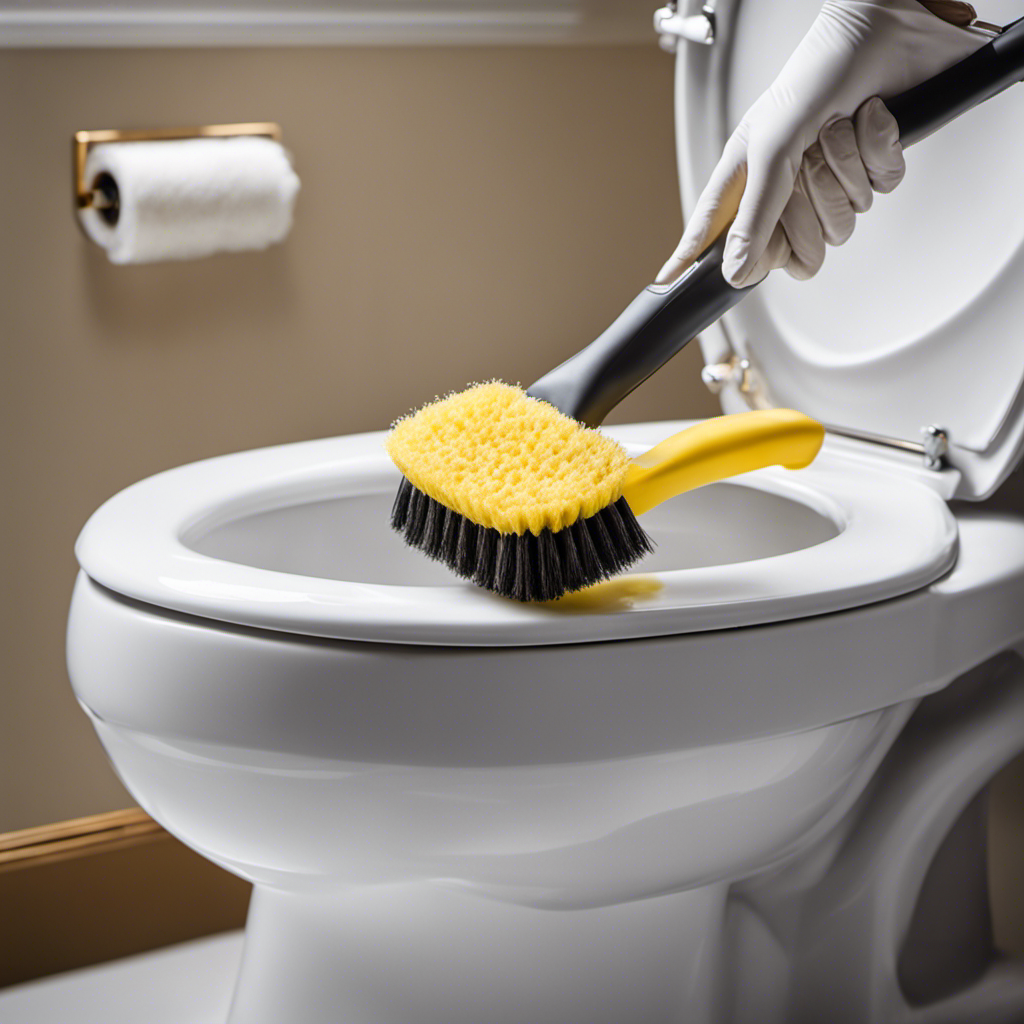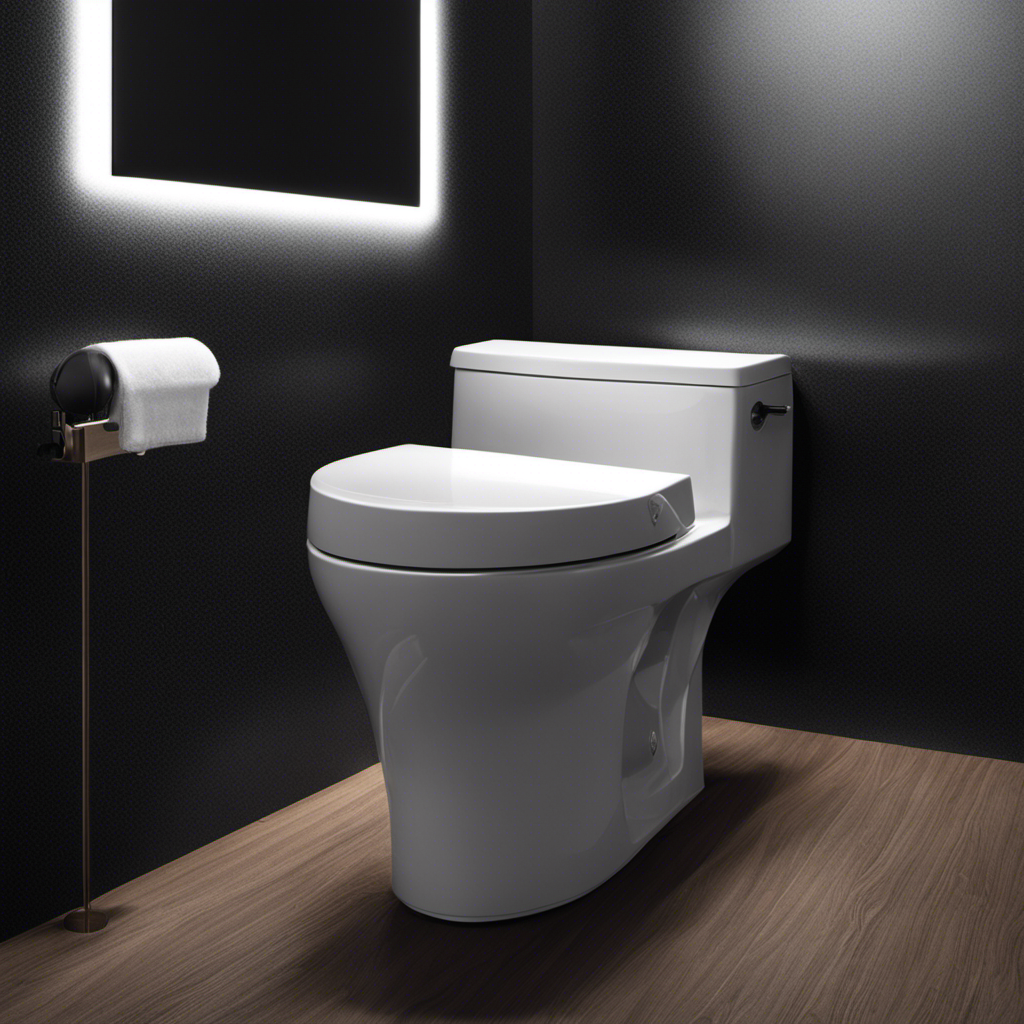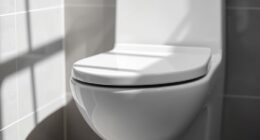As a bathroom enthusiast, I often ponder the spatial requirements of a toilet. How much room does it truly need? In this article, we will delve into the dimensions, clearances, and minimum space requirements for a toilet.
I will guide you through ideal toilet layouts and provide accessibility guidelines. Additionally, we will explore considerations for small bathrooms and highlight common mistakes to avoid.
So, let’s embark on this informative journey to uncover the secrets of toilet room requirements.
Key Takeaways
- Minimum toilet dimensions are around 14-16 inches wide and 27-30 inches long.
- Recommended front clearance is at least 21 inches.
- Minimum distance from center of toilet to sidewall or obstruction is 15 inches.
- Doorway leading to the bathroom should have a minimum width of 32 inches.
Dimensions and Clearances
The toilet’s dimensions and clearances determine how much space it needs in a bathroom. When it comes to minimum toilet dimensions, it’s important to consider both the length and width of the fixture.
The standard size for a toilet is around 14-16 inches wide and 27-30 inches long. However, there are also compact toilets available that are slightly smaller, measuring around 12-14 inches wide and 24-26 inches long.
As for recommended toilet clearances, it’s crucial to ensure that there is enough space around the toilet for comfortable use. The front clearance should be at least 21 inches, while the side clearance should be around 15 inches. This allows for easy access and movement, especially for individuals with mobility issues.
Overall, understanding the minimum dimensions and recommended clearances is essential for optimizing the functionality and comfort of a bathroom.
Minimum Space Requirements
Make sure you have enough space to meet the minimum requirements for a toilet.
When it comes to toilet placement, there are certain plumbing requirements that need to be considered. The minimum space requirements for a toilet typically include a certain distance from walls and other fixtures to ensure proper functionality and comfort.
According to plumbing standards, the distance from the center of the toilet to any sidewall or obstruction should be at least 15 inches. Additionally, there should be a minimum of 18 inches from the center of the toilet to any other fixture, such as a sink or bathtub. These measurements ensure that there is enough space for easy access and movement around the toilet.
Now, let’s discuss the ideal toilet layouts and how they can optimize your bathroom space.
Ideal Toilet Layouts
To optimize your bathroom space, consider the ideal layout for your toilet. When it comes to toilet design, it’s essential to take into account the plumbing requirements and the overall functionality of the space. To give you a clear picture, here is a table showcasing four common toilet layouts:
| Layout | Description |
|---|---|
| One-Wall | The toilet is placed against one wall, with the tank and plumbing hidden within the wall. |
| Corner | The toilet is positioned in the corner of the bathroom, maximizing floor space. |
| Two-Wall | The toilet is placed between two walls, with the tank and plumbing visible. |
| Wall-Hung | The toilet is mounted on the wall, with the tank and plumbing concealed behind a false wall. |
Each of these layouts has its advantages and disadvantages, so it’s crucial to consider your specific needs and constraints. With the ideal toilet layout in mind, we can now move on to discussing accessibility guidelines for toilets.
Accessibility Guidelines
When designing your bathroom, it’s important to consider accessibility guidelines for the toilet. Universal design and wheelchair accessibility are crucial factors to keep in mind.
To ensure that a toilet is accessible, there are specific dimensions and requirements to follow. First, the doorway leading to the bathroom should have a minimum width of 32 inches to accommodate a wheelchair.
Inside the bathroom, there should be enough space for a wheelchair to maneuver comfortably, with a recommended minimum turning radius of 60 inches.
The toilet itself should have a height between 17 and 19 inches, making it easier for individuals with mobility issues to sit and stand. Grab bars should also be installed near the toilet, providing support and stability.
Considerations for Small Bathrooms
Designing a small bathroom? Consider the dimensions of the doorway and maneuverability space for wheelchair accessibility.
When it comes to compact toilet options, there are a few things to keep in mind. Firstly, choose a toilet with a smaller footprint to maximize space. Wall-mounted toilets are a great option as they save floor space and provide a sleek, modern look.
Secondly, consider the height of the toilet. Opt for a comfort height toilet, which is slightly taller than standard toilets, to ensure ease of use for everyone.
Lastly, don’t forget about creative storage solutions. Utilize vertical space with wall-mounted shelves or cabinets to keep toiletries and other essentials organized and within reach.
With careful planning and the right choices, you can create a functional and stylish small bathroom that meets all your needs.
Common Mistakes to Avoid
When designing your small bathroom, it is important to measure the dimensions of the doorway and the space for wheelchair accessibility.
When it comes to toilet installation in a small bathroom, there are a few common mistakes that you should avoid. Here are three things to keep in mind to ensure a smooth and efficient installation:
-
Plumbing requirements: Before installing a toilet, it is important to consider the plumbing requirements. Make sure you have the necessary plumbing connections in place, including water supply lines and drainage pipes. It is also crucial to ensure that the existing plumbing system can support the installation of a toilet.
-
Space constraints: In a small bathroom, space is often limited. When choosing a toilet, opt for a compact design that fits well within the available space. Consider the distance between the toilet and other fixtures, such as the sink or shower, to ensure proper functionality and comfort.
-
Accessibility: Accessibility is key, especially if you have elderly or disabled individuals in your household. Ensure that there is enough space around the toilet for easy maneuverability, including clearance for a wheelchair if needed. Additionally, consider installing grab bars for added safety and support.
Conclusion
In conclusion, when determining the amount of room needed for a toilet, there are several factors to consider. From dimensions and clearances to minimum space requirements, it is crucial to adhere to accessibility guidelines.
Ideal toilet layouts should promote comfort and functionality, while considerations for small bathrooms may require creative solutions.
To avoid common mistakes, careful planning and attention to detail are essential. By following these guidelines, you can ensure a well-designed and efficient toilet space that meets all necessary requirements.










